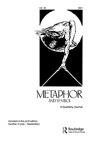交际方式和说话人身份对隐喻框架的影响
IF 3.3
3区 文学
0 LANGUAGE & LINGUISTICS
引用次数: 5
摘要
摘要人们经常在各种不同的交际环境中遇到隐喻,但大多数对隐喻框架的研究都完全依赖于书面材料。在三个实验中(N=2399),我们检验了隐喻框架在不同交流形式中的相对力量。参与者阅读、听到或观看某人报告一系列隐喻性的问题。他们通过在两个回答选项中进行选择来回答每个问题的目标问题,其中一个选项在概念上与隐喻框架一致。结果显示,在每种交际模式中,隐喻框架效应大小相似。说话者的性别和种族都不能可靠地调节视听信息隐喻框架的效果,尽管当说话者和观察者的性别匹配时,框架效果更强。我们还重复了这一发现,即当隐喻扩展到反应选项语言中时,它们会更有效。这些结果为隐喻框架的有效性和可推广性提供了新的见解。本文章由计算机程序翻译,如有差异,请以英文原文为准。
Effects of Communication Modality and Speaker Identity on Metaphor Framing
ABSTRACT People regularly encounter metaphors in a variety of different communicative settings, but most studies of metaphor framing have relied exclusively on written materials. Across three experiments (N = 2399), we examined the relative power of metaphor framing in different communication formats. Participants read, heard, or watched someone report a series of metaphorically framed issues. They answered a target question about each issue by selecting between two response options, one of which was conceptually congruent with the metaphor frame. Results revealed a similarly-sized metaphor framing effect in each communication modality. Neither speaker gender nor race reliably moderated the effects of metaphor framing for audiovisual messages, though framing effects were stronger when the gender of the speaker and observer matched. We also replicated the finding that metaphors are more effective when they are extended into the response option language. These results provide new insights into the efficacy and generalizability of metaphor framing.
求助全文
通过发布文献求助,成功后即可免费获取论文全文。
去求助
来源期刊

Metaphor and Symbol
Multiple-
CiteScore
2.90
自引率
0.00%
发文量
23
期刊介绍:
Metaphor and Symbol: A Quarterly Journal is an innovative, multidisciplinary journal dedicated to the study of metaphor and other figurative devices in language (e.g., metonymy, irony) and other expressive forms (e.g., gesture and bodily actions, artworks, music, multimodal media). The journal is interested in original, empirical, and theoretical research that incorporates psychological experimental studies, linguistic and corpus linguistic studies, cross-cultural/linguistic comparisons, computational modeling, philosophical analyzes, and literary/artistic interpretations. A common theme connecting published work in the journal is the examination of the interface of figurative language and expression with cognitive, bodily, and cultural experience; hence, the journal''s international editorial board is composed of scholars and experts in the fields of psychology, linguistics, philosophy, computer science, literature, and media studies.
 求助内容:
求助内容: 应助结果提醒方式:
应助结果提醒方式:


